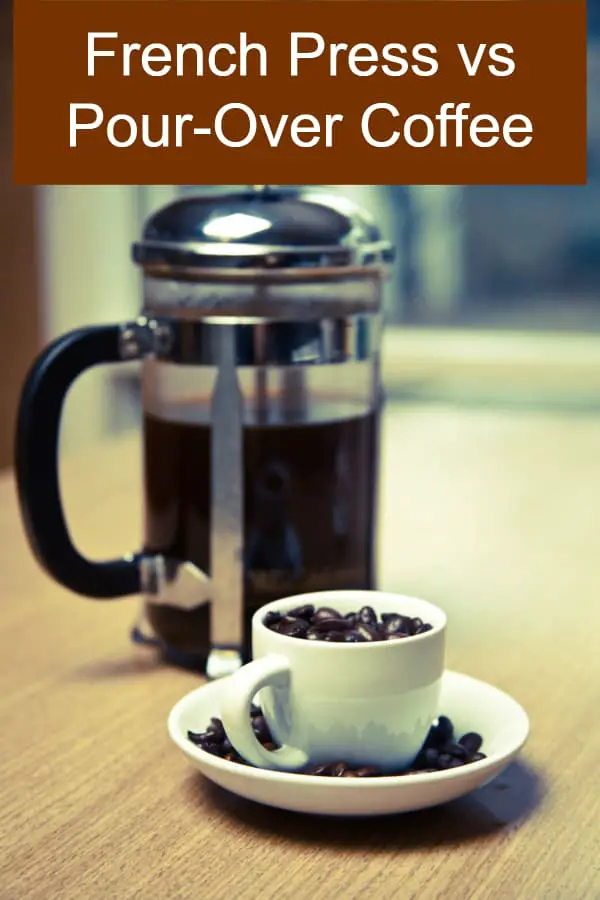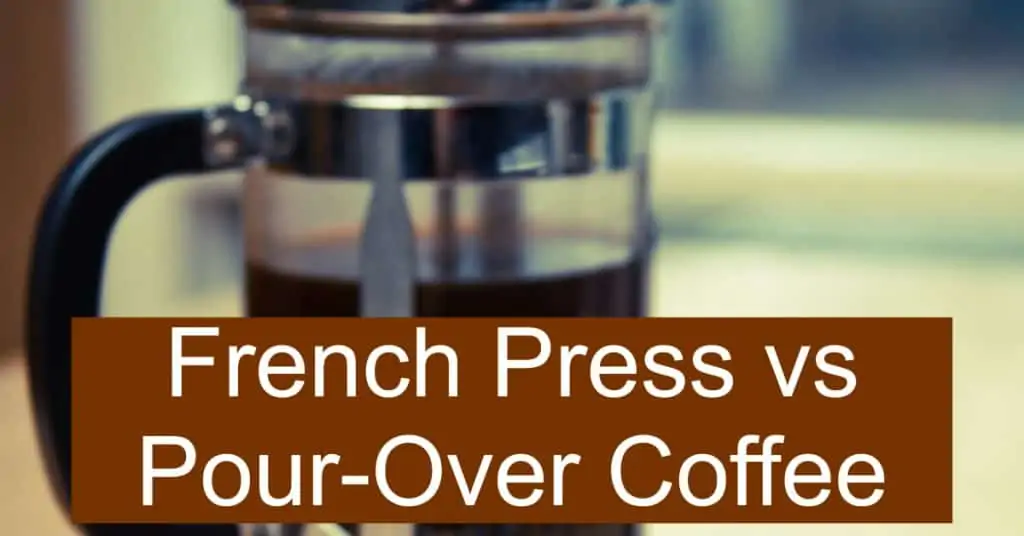Coffee is a passion for many people worldwide, and in recent years the focus on home brewing has become even more popular. While drip brews and espresso beverages may lead the way, manual coffee brewing is also becoming trendy.
From commercial bankers to stay-at-home parents, you can look at any counter and discover a pour-over or French press coffee setup. If you wonder what the buzz is about this upcoming trend, our deep dive into these brewing methods is a great place to start your research.
We will let you know upfront that both options result in a fantastic cuppa. The method and preparation do differ, however. Hopefully, by the end of our guide, you will be better equipped to chose which way will work best for your lifestyle.
What is a French Press? – How Does it Work?
The French press is also referred to as a cafetiere and first popped on the scene at the end of the 1920s. It’s been modified numerous times over the last several decades, resulting in the easy-to-use French press that we know and love today. Although the French press has a romantic and complicated sounding name, it is actually quite simple. It works by steeping coffee grounds in hot water and then separating them to leave behind perfectly brewed coffee. This immersion method is also the same used for cold brewing coffee and teas.
French press immersion brewers are rather easy to use no matter what level of homebrewer you may be. Once you learn how to properly steep your grounds and clean your brewing device, you will be able to make fresh coffee within a few minutes any time you like. All you have to do is to place your coffee grounds in the cylindrical glass carafe. Then, pour the desired amount of hot water over the grounds, fully immersing them. Allow the grounds to steep anywhere from three to ten minutes depending on your desired strength, and then “press” them. The press portion is basically depressing the stainless steel filter via the plunger. This will push the grounds down through the liquid and trap them at the bottom of the carafe.
How is Pour Over Coffee Made?
Pour-over coffee is one of the oldest methods of making coffee that is starting to see a comeback. Imagine a drip brew, but on a smaller scale and done by hand. Not only is pour-over brewing elegant, but it also creates a wonderfully flavorful cup of customized coffee. Immersion brewing steeps coffee grounds. However, pour-over brew introduces the grounds to fresh water as it passes through. Although it is a hand form of drip brewing, the process is a bit different than you will find from a filtered drip coffee machine.
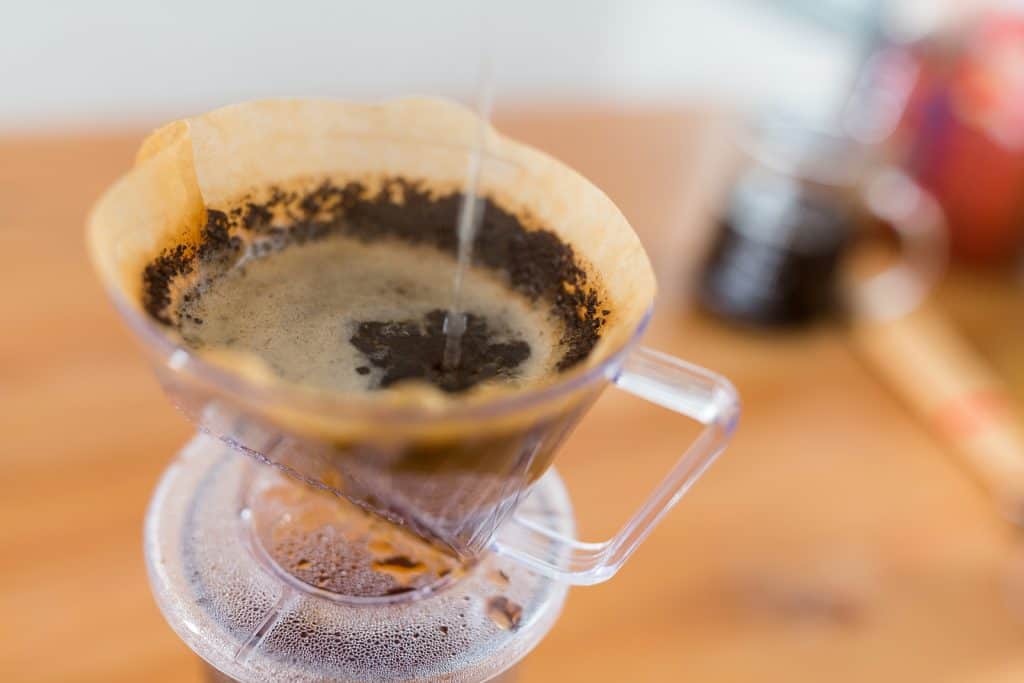
The pour-over coffee method is exactly how it sounds. You will pour hot water over fresh coffee grounds that sit at the bottom of a cylindrical-shaped filter. The water will go around the filter in a circle surrounding the grounds and pass through into a cup or pot below. This is considered an infusion method of brewing that allows you to capture the grinds’ full flavor while leaving the natural oils in the filter. It also helps to prevent the coffee grinds from getting too saturated, which can dilute the brew and leave you with a weak cup of coffee.
Pour-over coffee is straightforward to brew. The main things you need to pay attention to are how course your grinds are and how long you brew your pour. It takes about ten minutes from start to finish to make a pot of pour-over brew. The actual time to brew is around three minutes for a light roast and four minutes for a dark roast. All you have to do is affix your grounds in your filter, pour a small amount of hot water over them, and let the coffee bloom for about half a minute. Then, slowly pour the remaining water, neither quickly nor so slow that the grounds dry out.
Which Manual Method is Easier to Brew?
Both French press brewing and pour-over coffee brewing are simple to do and easy to clean up. You can create a flavorful cup of coffee at home that rivals some of the best coffee houses in the country. There are some small differences in taste and strength, but it all comes down to personal preference at the end of the day. With French press brewing, you immerse coffee grounds in the bottom of a pot and then press the ground to trap them before serving your coffee. The pour-over method uses a filter over which you simply pour hot water directly.
Both methods are straightforward, but for those who are used to brewing coffee in a regular drip machine, pour-over brewing will be easier. Though not complicated, with a French press, you do need to time your immersion correctly, or you will end up with coffee that is either too light or too dark.
What Kind of Coffee Grounds Do You Need? Fine? Coarse?
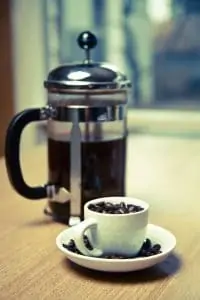
Pour-over coffee that is brewed manually needs a specific type of grind. For the best results, you will need to use medium to medium-fine coffee grounds. Anything larger will be too big for brewing, and anything smaller will slip through the holes of the filter resulting in a chewy brew. This size is just a bit smaller than sand but not as small as coffee grounds that are used for espresso.
French press brewed coffee is another manual brew that requires a specific size of the grind. For the best results, you will need to use coarse coffee grounds. This type of grind is larger than most types and is about the size of sea salt grains. Anything smaller will slip through the holes of the French press filter and mix with the coffee liquid.
If you simply want to brew some espresso-like coffee then you do need to use a Moka Pot instead. It won’t matter whether the Moka Pot is made from aluminum or steel!
Is Pour-over or French Press Brewing Unhealthy?
Coffee is both good and bad for your heart. Depending on what you add to your morning cuppa and even how it is brewed, you can be increasing your risk of heart disease with every sip. Half-and-half is well known to be full of excess sugar and fats, which of course has the potential to increase your cholesterol. But did you know the way you filter your morning brew can also have a dramatic effect on your cholesterol levels?
Coffee beans naturally contain oils that give your beverages their rich flavors and bold colors. The more filtered your coffee is, the fewer oils will actually pass through to your brew and into your body. You may be wondering how any of this affects manual brews, and if they do, which is healthier, French press or pour-over. The main difference comes down to filtering. According to scientific research, unfiltered coffee allows all oils to pass into the brew, which in turn is bad for your heart over time. Filtered coffee, however, reduces the oils and is better for your heart than unfiltered coffee.
French press coffee is brewed with course grounds immersed in water. Although the grounds are filtered from mixing with the liquid when you drink your brew, the oils are not filtered out of the beverage. Pour-over coffee uses a filter and blocks a higher percentage of coffee oils from mixing with your final brew. So, while coffee can be heart-healthy, overall, a French press brew is going to increase your lipid levels faster than a pour-over brewed cup of coffee.
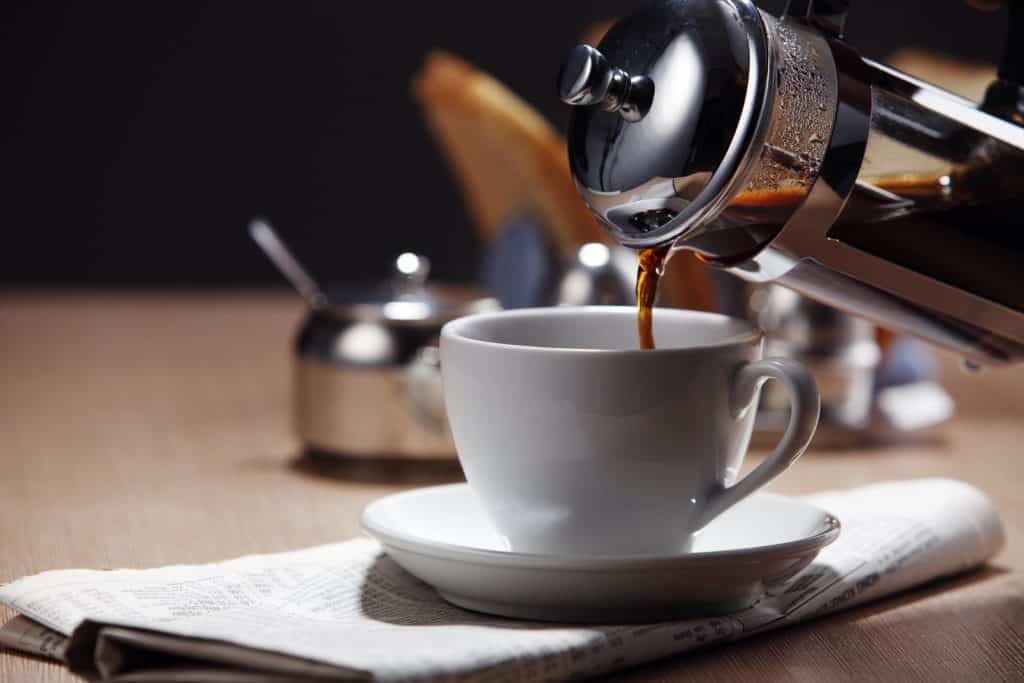
How Easy Is It To Customize Your Brew?
You can control the strength and flavor of your French press brew easily. Always make sure your water is around 195°F for the best results. Pour a small amount of hot water over the grounds and allow the bloom or froth to bubble up for about 30 seconds before pouring more hot water into the carafe. This will boost the flavor of your coffee and make for a well-balanced cuppa. The longer you steep your grounds, the strong your brew will be, the less steep time, the lighter it will be. You can also choose a dark roast if you prefer a stronger flavor but want to brew for a shorter period.
The pour-over method allows you to create a perfectly blended cup of coffee that is smooth but ground-free. There are fewer oils since the filter will trap them, but the flavor will pass through deliciously. You can easily customize your brew by adding different grinds, spices, or even raw sugar to your filter. It is not really possible to make a very strong brew with the pour-over method because it is an infusion rather than immersion, but that doesn’t mean it is any less delicious. Using a recipe is the best way to get a consistent cup of manual brew regardless of which method you choose.
Is Pour Over Coffee Equipment Cheaper Than a French Press?
Cost is always a factor when it comes down to which type of coffee equipment you choose to invest in. Let’s break down the cost of both the French press and a pour-over coffee set up to see which would best suit your lifestyle.
Before we get into it, both methods require the use of ground beans. You can always buy pre-ground beans from the store, but the most flavorful cuppa will come from freshly ground coffee beans. Whole beans can also be stored for longer and your coffee won’t go bad.
That being said, in order to manually make a balanced cup of coffee, you will need a high-quality grinder for your kitchen. The flavors of the coffee beans start to decay 30 minutes after they are ground, which is one of the reasons you should always grind just before you pour or press your coffee.
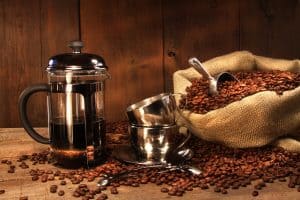
To create a pour-over brewing setup, you need a pour-over kettle, a pour-over dripper, and of course, a grinder. It is best to buy a kettle specifically made for pour-over coffee brewing, though you can use a regular kettle you already have at home in a pinch. Pour over kettles run between $30 and $50, and they last virtually forever. The pour-over filter cone usually will cost you between $20 and $40, depending on the brand and quality you choose.
To create a French press brewing setup, you will need a French press and a grinder. The cost of a French press will range from $15 up to $200 depending on how fancy you like to be. We suggest avoiding the cheapest models as they will not last very long and can have a negative effect on the taste of your coffee. Choose one made with borosilicate glass that is heat resistant and is paired with a stainless steel frame. You can get a good quality French press for around $30.
In comparison, a French press setup will be cheaper than a pour-over setup if the grinder’s cost is not included since both require a high-quality grinder. In terms of grinders, it is a good idea to invest well into a better coffee grinder regardless of what setup you prefer. The better the grinder, the smoother your final brewed beverage will be.
Final Thoughts
A French press allows you to keep the grounds out of your coffee without affecting the oils or other natural flavors. The only downside is that your immersion time will directly affect how good your cup of coffee tastes.
If you are in a rush and steep your grounds only for a few minutes, you may end up with a lighter cup of coffee than you prefer. The poured-over method of brewing will give you a very smooth cuppa similar to that produced by a regular drip machine.
Because it is used with a filter, it is also very easy to clean. The main drawback of the pour-over method of brewing is the reduction in flavor due to the oils that get trapped in the filter.
